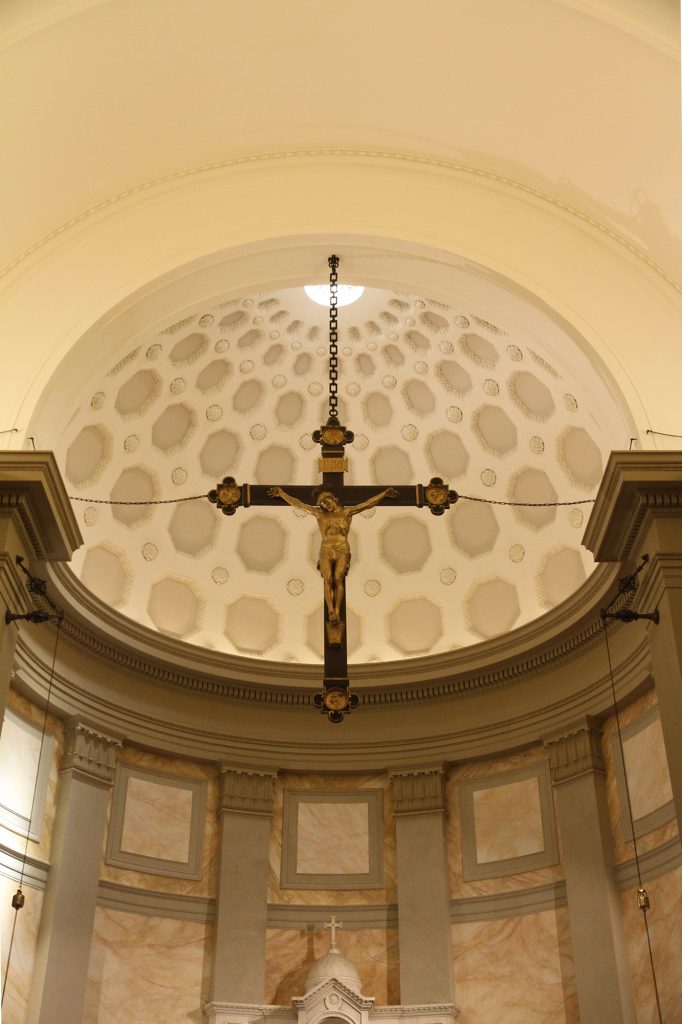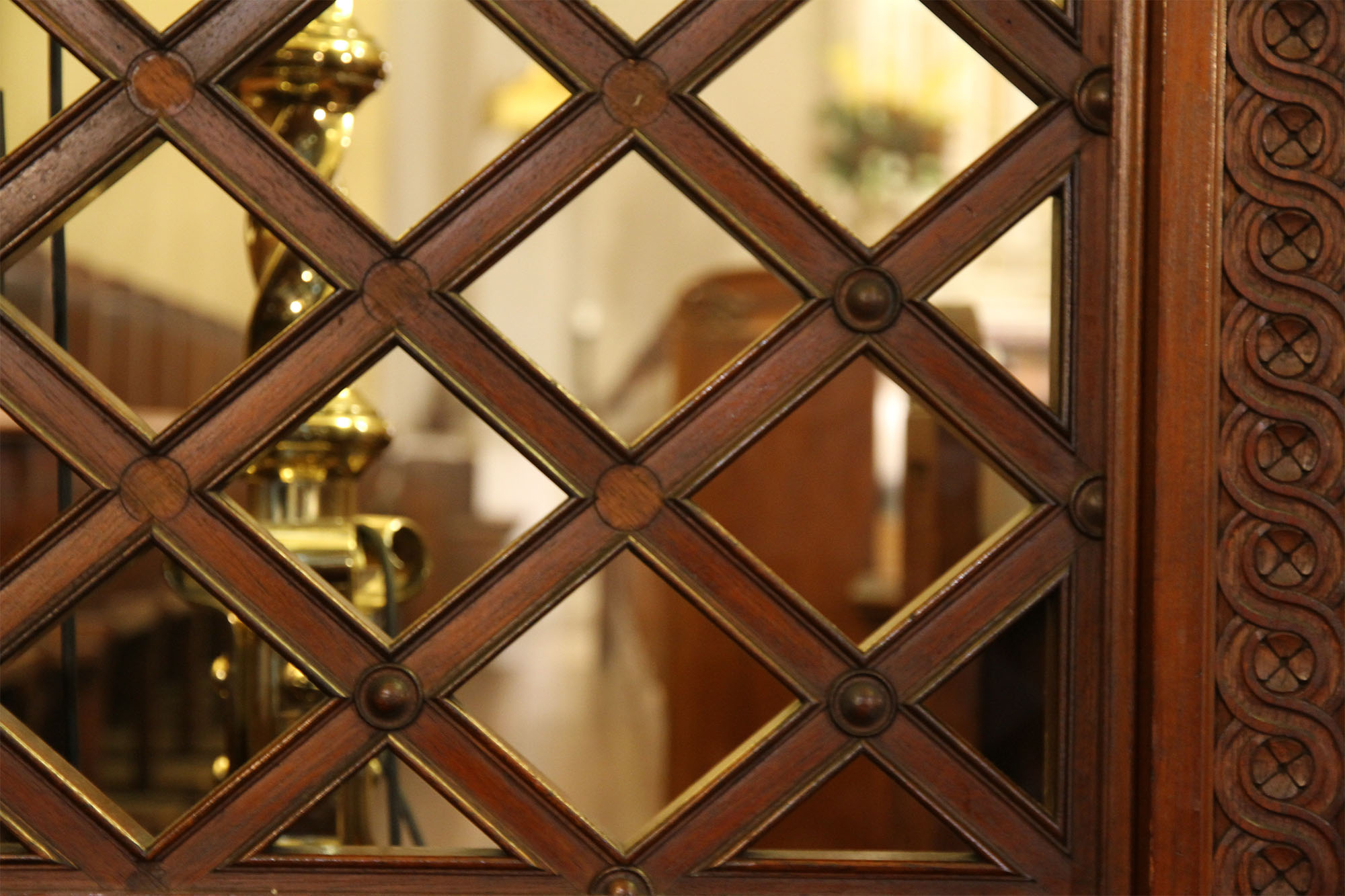
OUR CHAPEL FOUNDATIONS
The Maternal Heart of Mary Chapel was founded by the Little Company of Mary sisters. It was the convent chapel for use by the sisters living and working on the Lewisham Hospital site until 1988. Lewisham Hospital was founded by the sisters of the Little Company of Mary. The grounds now belong to the St Vincent de Paul Society.
The laying of the foundation stone of Maternal Heart Chapel marked, to the very day, the Silver Anniversary of the arrival in Australia of Mother Xavier Lynch, who was to become Provincial Superior of the Little Company of Mary. For many years the Blue Nuns provided Sydney with an unparalleled service at Lewisham Hospital. The opening of the chapel was marked by a Solemn Pontifical Mass celebrated by Archbishop Michael Kelly on 18 September 1927, the Golden Anniversary year of the foundation of the Little Company of Mary by the saintly Mother Mary Potter at Nottingham, England. Three archbishops and seven bishops were in attendance. After a day of festivities Solemn Pontifical Benediction was given by Archbishop Redwood of Wellington.
In 1884 Patrick Francis Moran met Mary Potter while in Rome on his way from Ireland to Australia to take up his appointment as the third Archbishop of Sydney. After a year of assessing for himself the needs of the poor and suffering in his new diocese Moran was summoned to Rome. When he arrived home in Sydney on 4 November 1885 as Australia’s first Cardinal he was accompanied by six of Mary Potter’s sisters. They soon became renowned for the tender and loving care given to the sick and to the dying in their homes, and for the special reverence with which they laid out the bodies of the dead.
From their arrival the sisters lived in rented or borrowed accommodation, until on 4 October 1887, the Feast of St Francis of Assisi, they were able to move into their own convent built on land at Lewisham given to them the previous year by the Cardinal. By Christmas 1887 there were 25 sisters and postulants living in the convent. On 19 August 1888 the foundation stone of the new Children’s Hospital of the Holy Child was laid by Bishop Murray of Maitland and on 9 June 1889 the first wing of the hospital was opened by the ever helpful Cardinal Moran. The opening of the first chapel took place on 25 March 1893.
On 7 August 1898 His Eminence blessed yet another foundation stone, this time for the General Hospital. On that one day £800 was collected toward the projected £6,000 cost of the hospital. Such was the esteem in which the citizens of Sydney, Catholic, Protestant, Jewish and agnostic held the Blue Nuns that fund-raising was rarely a problem for them in those pioneering days. When Maternal Heart Chapel was opened in 1927 £19,826/4/- of the £23,831/17/- cost had already been raised. In May 1911, three months before his death, Cardinal Moran blessed the last of the seven foundation stones laid at Lewisham during his lifetime, for a new hospital wing.
Dr Edward McMahon described in his 1972 Lewisham Lecture a most significant event which occurred in 1899:
“The golden era of Lewisham Hospital dawned with the arrival of Mother Xavier in Sydney on 21 August 1899. Mother Xavier was a dynamic figure who set out to promote Lewisham and establish the Order, not only in Australia and New Zealand, but also as far afield as South Africa. She was always an immaculately robed and imposing figure as she glided along the corridors. She would have been a great person in any walk of life. She promoted the hospital and the community of Blue Sisters in an expert and untiring manner with nothing but the best being good enough.”
At the celebrations which followed the chapel opening Dr Maurice O’Reilly, Rector of St John’s College, paid tribute to the magnificent activities of the Mother Provincial who was a woman of big ideas, inasmuch as one with less pluck would have been content with a building less imposing than a chapel costing over £23,000. He pointed out how well the money had been used, and further that the large gathering indicated the affection in which the Sisters were held. The proceedings were broadcast (but not on 2SM which did not then exist).
The chapel was solemnly consecrated on 5 December 1935.
In 2019, the Church was entirely repainted and rewired with the help of many generous benefactors.
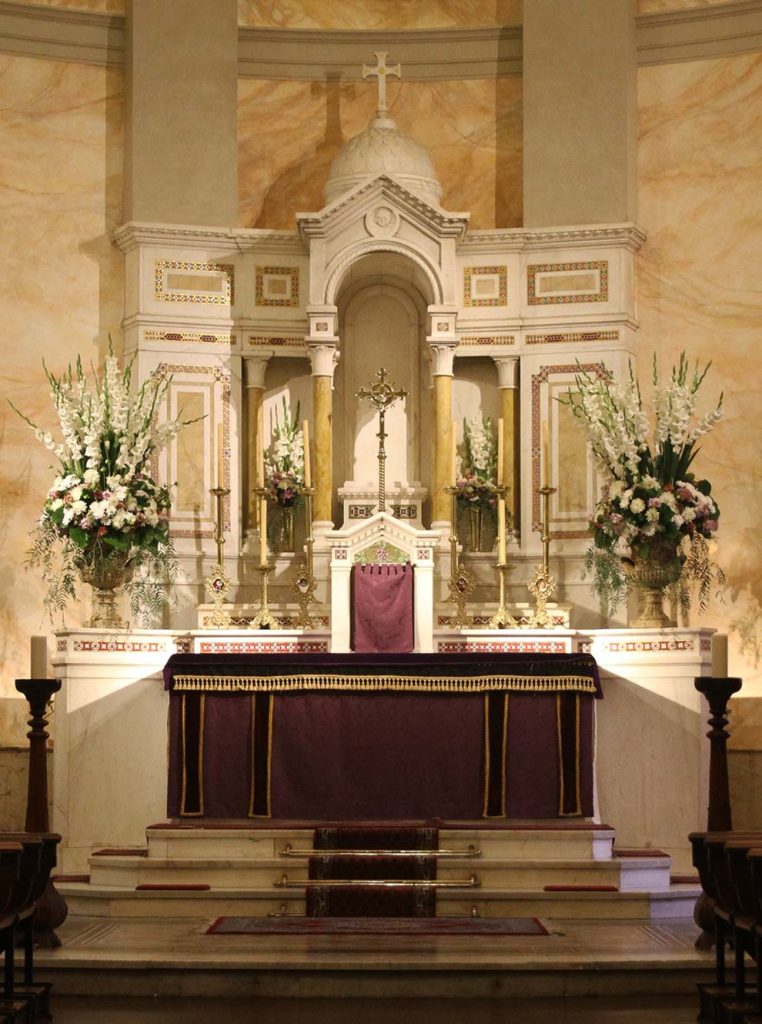
Acknowledgements
Architects: Wardell and Denning.
The High Altar, dedicated to the Maternal Heart of Mary, was built by McBride Studios, of Pietrasanta, Italy, and was the gift of Sir Mark and Lady Sheldon, in memory of T J Dalton.
The four side altars, dedicated to the Sacred Heart of Jesus, Saint Michael, Saint Joseph, and Saint Francis Xavier were built by Melocco Bros of Sydney, who were also responsible for the mosaic paving in the sanctuary.
The bronze crucifix was the work of a Roman sculptor of the period, Professor D Mastroianni. The large Crucifix was donated by Mr E.F. (Ted) O’ Brian in honour of his sister, Rev Sr Ephrem (LCM)
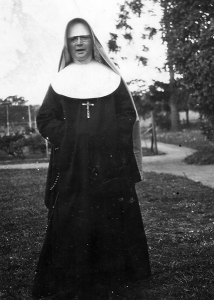
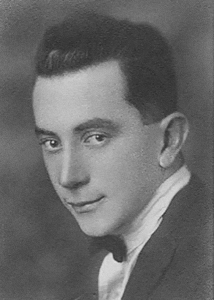
FOUNDER OF THE CHAPEL:
MOTHER XAVIER LYNCH
A biographical extract from the Australian Dictionary of Biography
– Lynch, Annie (1870 – 1938) by J. C. H. Dewdney
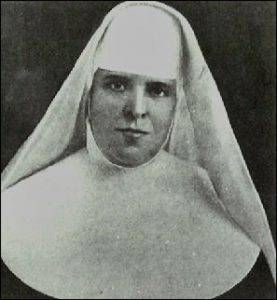
Annie Lynch (1870-1938), religious and hospital administrator, was born at Virginia, Cavan, Ireland, daughter of a grazier, and his wife Annie, nee O’Reilly. Educated by the Sisters of Mercy at nearby Ballyjamesduff, she joined the Little Company of Mary, a congregation devoted to the care of the sick and the dying, on 1 April 1887. She spent seven years at the congregation’s mother house in Rome as a postulant and novice under the immediate care of Mother Foundress Mary Potter. Her novitiate completed, she took the religious name Mary Xavier. Accompanied by three other ‘Blue Sisters’ (the title deriving from their blue veils), she was sent in 1894 to establish a hospital in Malta.
Recalled from Malta, Mother Xavier was dispatched to Sydney where the congregation ran Lewisham Hospital and Mount St Margaret psychiatric hospital; strains were developing among the Sisters and between them and the archdiocesan authorities. She arrived on 21 August 1899 on a six-month term as visitor-general. Years later she wrote: ‘At Sydney things were at first very precarious, but within three months everything was right again and Cardinal Moran was a staunch friend of the Little Company of Mary’. By 31 December she had been appointed superintendent.
Among the twenty-eight successful candidates at the Australian Trained Nurses’ Association’s examination for registration in 1906 were Mother Xavier and thirteen other religious from Lewisham. During her years as superior at Lewisham the small hospital for women and children became one of Sydney’s leading general hospitals (male patients were admitted in 1912) and nurses’ training schools. At least one surgeon S. H. Harris, impressed by the skilled and dedicated nursing of the Sisters, did much of his operating there. A stern but just disciplinarian at Lewisham, Mother Xavier was selflessly solicitous for the welfare of those in her charge.
In November 1899 she had acquired a hospital at North Adelaide, staffed by five Sisters from Lewisham, and in 1904 she sent four Sisters to establish a hospital in South Africa. Early in 1914 she took four Sisters to establish a house at Christchurch, New Zealand, returning next year for the laying of a foundation stone for a congregation hospital. In between she attended the congregation’s first general chapter in Rome and visited hospitals in England, Ireland and the United States of America. In 1922 the Little Company of Mary was constituted into four provinces – Italy, England, Ireland and Australasia – and Mother Xavier was first provincial of Australasia for two three-year terms. She retired as superior at Lewisham to devote more time to provincial affairs, visiting New Zealand and Rome in 1924, and oversaw the establishment of hospitals at Wagga Wagga in 1926 and Wellington, New Zealand, in 1927.
Slightly above medium height, with graceful carriage and a hearty laugh, Mother Xavier loved music and dance and had a notable mezzo-soprano voice. Visitors to the hospital were impressed with her brilliance and charm. In 1929 she retired to the congregation’s rest-home at Wollongong where she died on 7 June 1938; she was buried in Rookwood cemetery. Her memory rests on her achievements as one of Australia’s most noted hospital and nursing administrators and in extending the work of the Little Company of Mary in the Southern Hemisphere.
Alternative Name: Mother Xavier
Born: c.1870 at Virginia, Cavan, Ireland
Died: 7 June 1938 at Wollongong, New South Wales, Australia
Occupation: Catholic religious sister and hospital administrator
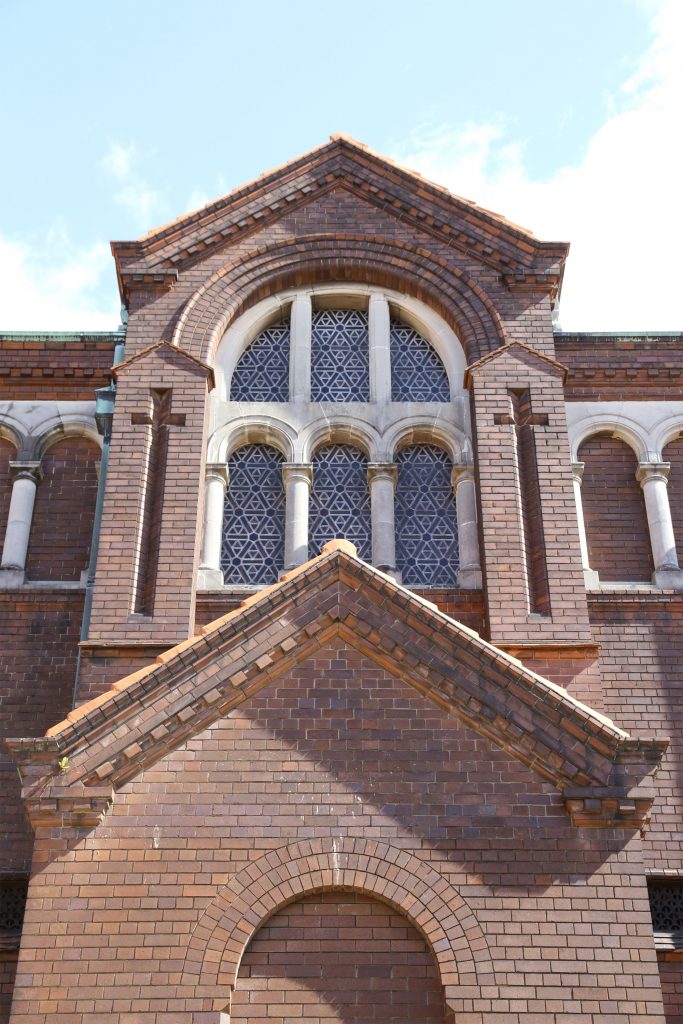
CHAPEL FEATURES
In 1990 the consultants who drew up the conservation plan for the former hospital site found the chapel to be of significance to the whole State of New South Wales, saying that it:
“…demonstrates excellence in design and detailing, is aesthetically pleasing and a notable example of influence of Romanesque style on the traditional language for a religious building. It displays superb craftsmanship in brickwork, joinery, glazing, tiling and plasterwork. Demonstrates the height of display of wealth in Catholicism during the 20th century.”
The consultants made the following recommendations:
“This building is so specialised and such an excellent example of its type, that it could never be used for any other than its originally intended purpose. To do otherwise could be to remove its primary significance. It is the sum of all its parts and could not suffer loss of any of its internal fitments such as pews, choir, screens, altar, religious symbols and motifs without serious detriment to its meaning as a purpose built place of worship.
(It) could, of course, be preserved as it is – almost as a museum piece. While this approach would retain a very significant heritage item, it is not considered to be the most appropriate way of saving the building. It would be a more meaningful way of conserving and interpreting this excellent work of ecclesiastical architecture to find or create a demand for its use as as a place of worship, or for related gatherings.”
Since 1993 the chapel has been regularly used for the celebration, with official permission, of the traditional Latin Mass. These Masses are usually sung, using Gregorian chant, which had been described by the Second Vatican Council as ‘distinctive of the Roman liturgy; therefore, other things being equal, it should be given pride of place in liturgical services’. The chant’s importance to the musical heritage and to the living culture of the West has been increasingly acknowledged in recent years, even in secular circles.
Mother Xavier, who had many musical friends, including Madame Melba and John McCormack, insisted as always on the highest standards in everything her Sisters did. The nuns at Lewisham became famous for their music as well as their medicine, and released two LP records, which included some Gregorian pieces. No doubt Mother Xavier would be pleased to know that the preservation of the chapel built in tribute to her is linked in a special way to the preservation of the most distinctive form of Catholic music.
CHAPEL ORGAN
M P Moeller Inc. of Maryland, USA, built the pipe organ installed in 1928 to the side of the gallery. The Sydney organ consultant, Joseph Earnshaw, wrote soon afterwards:
“Recently it was my privilege to have installed in the lovely chapel connected to Lewisham Hospital, an ideal instrument with wonderful tonal variety, due to the excellent voicing of the pipes. The remarkable purity of each register is unique, enabling the player to use his couplers with fine effect. All the pipes are enclosed in a swell box; two manuals; built on the duplex system; containing nine stops (seven manual and two pedal); tubular-pneumatic action; adjustable pistons; crescendo pedal in addition to the ordinary swell pedal. The touch is delightful; prompt repetition; excellent workmanship. This fine organ … is a credit to the art of modern organ construction.”
By selecting such a fine instrument the perfectionist Mother Xavier showed that she would have agreed with the Second Vatican Council, when it decreed that the pipe organ is to be held in high esteem, for it is the traditional musical instrument that adds a wonderful splendour to the Church’s ceremonies and powerfully lifts up the spirit to God and to higher things.
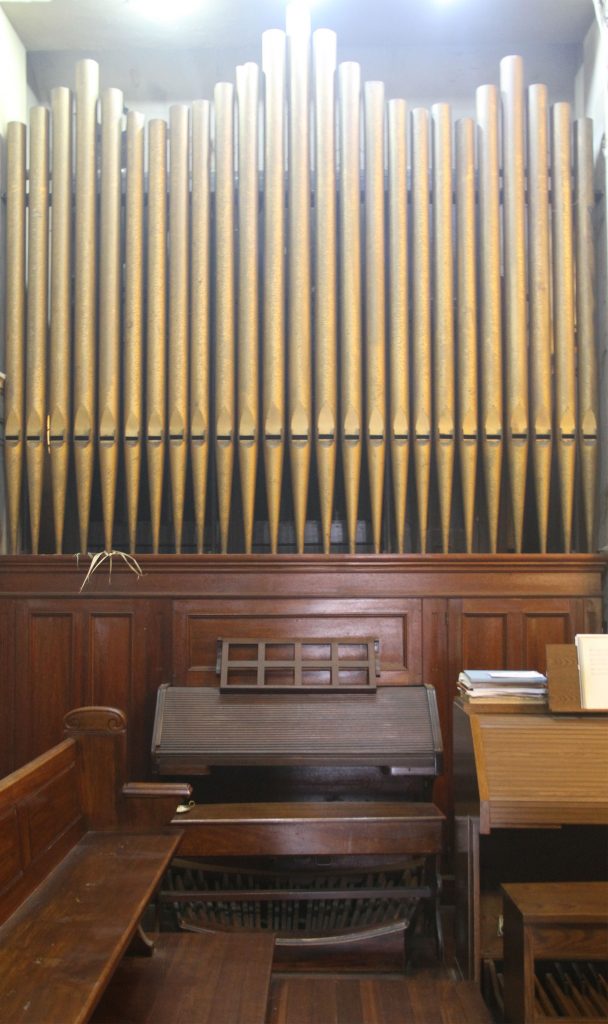
ANGEL FOUNTAIN
The fountain erected in honour of the Angel of Heart-felt Pity was erected in 1926, a gift from Mrs Margaret Ludlow. Her name also adorns the principal statue of The Maternal Heart of Mary that she donated to the Chapel.
The Little Company of Mary originally wanted to operate a cottage for blind children, but over the years, they expanded their apostolate in health care and enriched the lives of those who came within their influence and to the larger Australian community.
Due to the rapid development of the Lewisham site, it seemed that the landscape was always changing except for the one little constant “Angel of Heart-felt pity” fountain as it sat proudly hemmed in amongst the other buildings.According to Sr Pius (LCM), “it was such a beautiful feature, and while we Sisters never really had time to enjoy it, our patients and their visitors certainly did “ !
In keeping with monastic tradition, many religious orders and congregations have a fountain in the cloister to reflect the mystery of the Blessed Virgin Mary who is described as a “sealed fountain in a garden enclosed”. It is also a reminder that in the religious life, the practice of the virtues in union with Christ would enable a return to the pristine innocence of Eden.
It is unclear as to how long the fountain was in operation and fully functioning. The Little Company of Mary vacated the site in 1986, and by that time the fountain pool was filled in with soil, the beautiful marble angel and the perimeter plints had all been painted along with the sandstone courtyard and wall. It seemed that there was an effort to transform the area into an ornamental garden. There is a belief that some of the marble used was from the original marble from the first tomb of Bishop Bede Polding (OSB) who was buried at the old Lewisham cemetery which is the present campus we are situated on.
In 1987, the Society of St Vincent de Paul took ownership of the site. There was a renewed interest in the fountain when the Society of St Vincent de Paul moved into their new building site right in front of “our Little Angel” in 2010.
Work was begun by Mr Richard Amos and his friends with the blessing of the Society of St Vincent de Paul to restore this fountain to its original beauty and function in order to co-incide with the opening of the new building. The Latin Mass Maternal Heart of Mary Community made a contribution for this worthy restoration project.
In the course of restoration, it was discovered that the entire feature was carved from Carrara marble* Great care was taken to honour the heritage value of this fine piece of art, so much so that a decision was made to retain her historical character but also to reflect her true age and time-worn benevolence.
( Acknowledgement : Sr Mary Pius (LCM), Mr Richard Amos, Fr Duncan Wong FSSP, Miss Lucy O’ Connel)
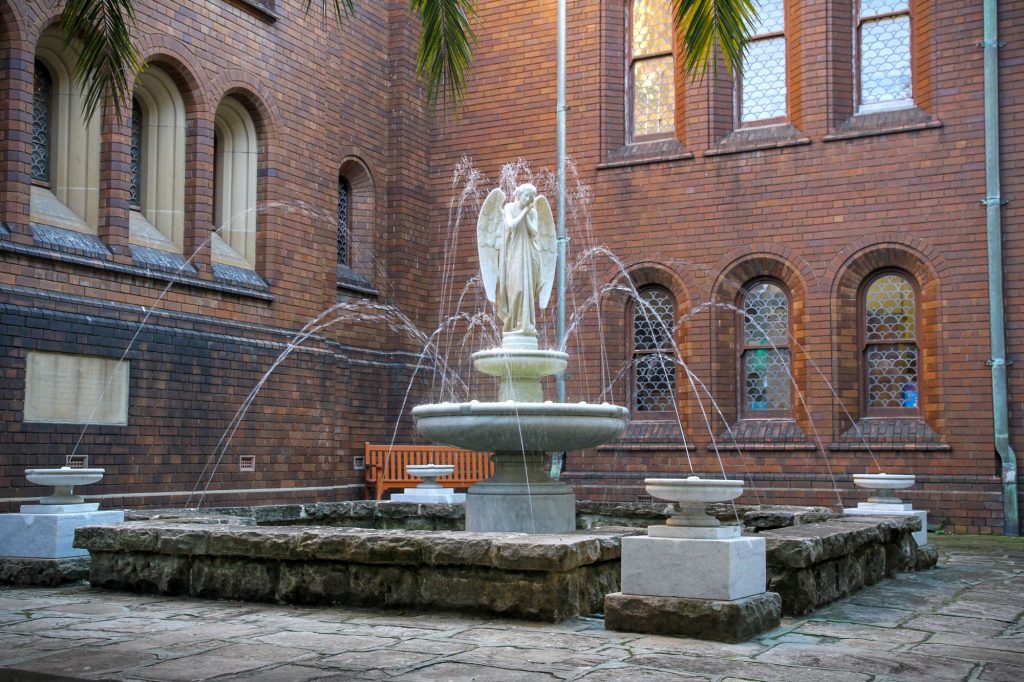
DEVOTION TO THE MATERNAL HEART OF MARY
Reflections by Dom Mark Daniel Kirby of the Silverstream Priory
– Benedictine Monks of Perpetual Adoration of the Most Holy Sacrament of the Altar
Immaculate Mother, in this place of grace, called together by the love of your Son Jesus the Eternal High Priest, we, sons in the Son and his priests, consecrate ourselves to your maternal Heart, in order to carry out faithfully the Father’s Will.
The Maternal Heart of Mary
I was surprised and moved to discover that, in referring to the Heart of the Blessed Virgin Mary, Pope Benedict XVI chose, from among any number of expressions possible, that of the Maternal Heart. It was a remarkable English woman, the Venerable Mother Mary Potter (1847-1913), who, with energy and perseverance, devoted herself to promoting the title of the “Maternal Heart.”
Mother Potter’s Marian Mission
At the end of 1874, Mother Potter received the inner certitude that she and the religious Congregation she was to institute (The Little Company of Mary) were called to foster devotion to the Maternal Heart of Mary.
“We are chosen,” wrote Mother Potter, “…to promulgate in God’s Church an increase of devotion to the Maternal Heart of Mary. We must increase our love for Our Lady and her sweet Maternal Heart, which makes us desire to propagate that devotion and to lead as many of God’s vast family as we can to love and honour that Heart.”
For Mother Potter, the Maternal Heart of Mary was a way of life:
Love that Heart, consecrate yourself to it, and make it your constant endeavour to be actuated by all the holy desires, wishes, and prayers that emanated from it. Let your sufferings, your actions, your words, your whole being renew again, on this earth, the life of Mary. To do this you must study Mary; to study her you must enter her Heart and observe its workings.
Desirous of giving an iconographic expression to the Maternal Heart, Mother Potter directed that an existing statue of the Mother of God should be artistically adapted to this end by adding to it the image of a heart surmounted by the lily of Our Lady’s immaculate purity, and pierced by the sword of her sorrowful compassion on Mount Calvary.
A Title Contested and Vindicated
The suitability of the title was the subject of some controversy, the principal objection being that it was novel, and that the Church had not recognized the Maternal Heart by authorizing its cultus in the liturgy. Opening her first house in Rome on 20 May 1884, Mother Potter succeeded in obtaining the blessing of Pope Leo XIII on its designation as the “Convent of the Maternal Heart of Mary.” In 1908, after building the heart-shaped chapel of Calvary Hospital (near the Church of Santo Stefano Rotondo) in Rome, Mother Potter was told by the Papal Master of Ceremonies, Msgr Carlo Respighi that it could not be dedicated under the title of the “Maternal Heart of Mary,” because no such title was in liturgical use. Mother Potter held her ground, and Msgr Respighi was obliged to seek the counsel of the Cardinal Vicar. Shortly thereafter, word reached Mother Potter that Pope Pius X had not only approved of the title “Maternal Heart,” but had further directed that a commemoration of the Maternal Heart should be made at every Mass during the octave of the new chapel’s dedication.
Consecration of the Church to the Maternal Heart of Mary
In July 1876, in obedience to Father Edward Selley, a convert from the Church of England, Mother Potter sought in fervent prayer an answer to her desire for a confirmation of her total consecration to the Maternal Heart of Mary. After making the Way of the Cross, and asking at each station for an answer to her prayer, Mother Potter received what, to my mind, must be taken as an inner locution on the part of Our Lady:
“My child, God, Almighty though He be, after the possession of Himself, cannot give me anything more desirable, more precious, or dearer than souls. This Jesus knew; and at His death, wishing to leave me a measure of His Love, confided the Church in the person of Saint John to my Maternal protection.
Come, then, to me! I am your Mother! An earthly mother can forget her child and lack in pity for it, but your Heavenly Mother will protect you in your day of sorrow. Come, then, to me, and bring to me the Church, which I have borne in my womb from the very time that I bore its Author, Jesus. May the holy vicar of My Son proclaim from his cross that I am the Mother of this Church. May he unite himself with his Master in saying to the nations of the earth, ‘Behold your Mother,’ and consecrate the Church confided to him, to my Maternal Heart, and I will show myself a Mother.”
Archbishop Kirby Enlisted in the Cause
A letter of Mother Potter, dated 17 September 1891 relates that she entrusted her spiritual director, Archbishop Tobias Kirby (1804-1895), Rector of the Irish College, with a letter to Pope Leo XIII in which she asked the Holy Father to consecrate the Church to the Maternal Heart of Mary. Five days later — was it by coincidence? — Pope Leo XIII addressed the following words to the universal Church in his Encyclical Letter Octobri Mense:
“Mary is this glorious intermediary; she is the mighty Mother of the Almighty; but-what is still sweeter – she is gentle, extreme in tenderness, of a limitless loving-kindness. As such God gave her to us. Having chosen her for the Mother of His only begotten Son, He implanted in her a maternal heart that breathes nothing but pardon and love. Such Christ desired she should be, for He consented to be subject to Mary and to obey her as a son a mother. Such He proclaimed her from the cross when he entrusted to her care and love the whole of the race of man in the person of His disciple John. Such, finally, she proves herself by her courage in gathering in the heritage of the enormous labours of her Son, and in accepting the charge of her maternal duties towards us all.
The design of this most dear mercy, realised by God in Mary and confirmed by the testament of Christ, was comprehended at the beginning, and accepted with the utmost joy by the Holy Apostles and the earliest believers. It was the counsel and teaching of the venerable Fathers of the Church. All the nations of the Christian age received it with one mind; and even when literature and tradition are silent there is a voice that breaks from every Christian breast and speaks with all eloquence. No other reason is needed that that of a Divine faith which, by a powerful and most pleasant impulse, persuades us towards Mary.”
Audience With Leo XIII
On 5 July 1896, shortly before leaving Rome to visit her houses in England, Mother Potter was granted an audience with Pope Leo XIII. The Pope spoke to her of the Church’s troubles, asking for Mother Potter’s prayers and those of her daughters. Then, addressing Mother Potter, the Holy Father asked her if she thought the Church would rise triumphant over her persecutors and emerge from the problems which beset her. Mother Potter answered at once: “Yes, if the Church were consecrated to the Maternal Heart of Mary, she would show herself a Mother.” The Holy Father was silent. The Sister translating into Italian for Mother Potter led the Holy Father to believe that she was asking for a liturgical feast in honour of the Maternal Heart. Pope Leo XIII then directed her to make a written petition to this effect and to address it to the Sacred Congregation of Rites. This, of course, was not Mother Potter’s primary desire. Her intention was to ask the Holy Father to consecrate the Church to the Maternal Heart of Mary. Nonethless, she was obedient to the Holy Father’s directive, and wrote her request to the Sacred Congregation of Rites. She never received a reply. In fact, she later learned, that the matter was never even discussed!
A Determined Woman
Towards the end of her life, Mother Potter intensified her campaign to obtain the consecration of the Church to the Maternal Heart of Mary. Among her supporters were Cardinal Merry del Val and the Abbots of Saint Paul’s Outside-the-Walls and of Grottaferrata. Mother Potter went so far as to commission a painting of Pope Pius X offering the Church to the Maternal Heart of Mary.
Pope Benedict XVI
The Venerable Mother Mary Potter died in 1913, firm in her conviction that God willed the consecration of the Church to the Maternal Heart of Mary by the Supreme Pontiff. Has her desire been fulfilled? One might pass in review the consecrations to the Immaculate Heart of Mary made by Pope Pius XII, the proclamation of the Virgin Mary as Mother of the Church by Pope Paul VI at the close of the Second Vatican Council, and the many Marian consecrations made by Pope John Paul II. All of this not withstanding, it seems to me that Pope Benedict XVI’s consecration at Fatima of all the priests of the Church to the Maternal Heart of Mary, very happily fulfills and crowns Mother Potter’s mission and desire. In consecrating all priests to the Maternal Heart of Mary, Pope Benedict XVI has, in effect, consecrated the entire Church to her Maternal Heart, for wherever and whenever a priest belongs to Mary by virtue of an act of consecration, multitudes of souls around him are drawn to her Maternal Heart.
– With kind permission from:
Dom Mark Daniel Kirby (OSB)
Prior of Silverstream Priory, Stamullen, County Meath, Ireland

